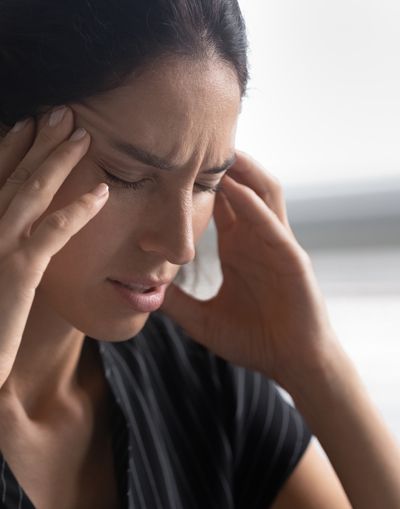Migraine Treatment NYC by Marc Bystock L.Ac.
"Research on acupuncture for migraine pain relief has shown promising results. Studies have found that acupuncture can reduce the frequency, intensity, and duration of migraines. I have found acupuncture treatments for migraines to be very successful."
-Marc Bystock L.Ac.
Pain Relief from Migraines by Marc Bystock NYC Acupuncturist in Midtown Manhattan NY 10016
What are Migraine Headaches?
Migraines are a type of headache characterized by intense throbbing or pulsing on one side of the head, often accompanied by nausea, vomiting, and sensitivity to light and sound. They can last anywhere from a few hours to several days, and some people may experience additional symptoms like visual disturbances or tingling in the limbs prior to the headache.
The exact cause of migraines is not fully understood, but it is believed to involve a combination of genetic and environmental factors. Migraines can be triggered by various factors such as certain foods, stress, hormonal changes, lack of sleep, or sensory stimuli like bright lights or strong smells.
Traditional medical treatment for migraines often involves medications to relieve symptoms and prevent future episodes. Over-the-counter painkillers, such as ibuprofen or aspirin, may provide relief for mild migraines, while more severe cases may require prescription medications specifically designed to treat migraines.
Acupuncture is a holistic treatment plan that addresses the cause of the symptoms and provides natural healing remedies as a solution.
Symptoms of Migraines
Here are some common symptoms associated with migraines:
- Headache pain: Migraines often cause moderate to severe throbbing or pulsating pain, typically on one side of the head. However, the pain can affect both sides or shift sides during an attack.
- Sensitivity to light and sound: Many people with migraines experience sensitivity to bright lights, loud noises, or certain odors. These stimuli can worsen the headache pain or even trigger an attack.
- Nausea and vomiting: Migraines frequently bring about gastrointestinal symptoms. Nausea and vomiting are common, and some individuals may have an upset stomach or abdominal pain.
- Visual disturbances: Some people experience visual disturbances called aura before or during a migraine attack. These can include flickering lights, blind spots, zigzag lines, or temporary loss of vision.
- Fatigue and dizziness: Migraines can leave individuals feeling tired, weak, and lacking energy. Some people may also experience dizziness or difficulty concentrating during an attack.
- Neck pain and stiffness: Neck pain or stiffness may accompany a migraine. It is not uncommon for the pain to radiate from the base of the skull to the neck and shoulders.
Causes of Migraines
Migraines can have various causes, but they are generally believed to result from a combination of genetic and environmental factors. Here are some common triggers that can contribute to migraines:
Hormonal changes: Fluctuations in estrogen, especially during the menstrual cycle, can trigger migraines in some individuals.
Food and drink: Certain foods and beverages, such as aged cheeses, chocolate, caffeine, alcohol, and processed or high-sodium foods, are known to trigger migraines in susceptible people.
Stress and emotional factors: High levels of stress, anxiety, or emotional upheaval can be migraine triggers. Similarly, changes in sleep patterns or lack of sleep can also contribute to their occurrence.Sensory stimuli: Bright lights, strong smells (perfumes, smoke), loud noises, and even flickering screens can trigger migraines in some individuals.
Physical factors: Intense physical exertion, including intense workouts or even sexual activity, can trigger migraines. Some people also experience migraines due to weather changes or high altitudes.
Medications: Certain medications, such as oral contraceptives or vasodilators, can increase the risk of migraines in susceptible individuals.
It's important to note that triggers can vary greatly from person to person, and what may cause migraines in one individual may not affect others in the same way. If you experience frequent migraines, it's a good idea to keep a migraine diary to identify patterns and potential triggers.
Traditional Medicines Given to Patients with Migraines and Their Known Side Effects
There are several types of medications that are commonly prescribed to manage migraines. Here are a few examples of the most common:
- Triptans: Triptans, such as sumatriptan or rizatriptan, are often used to treat migraines. They work by constricting blood vessels and reducing inflammation in the brain. Side effects can include dizziness, drowsiness, chest tightness, and nausea.
- Nonsteroidal anti-inflammatory drugs (NSAIDs): NSAIDs like ibuprofen or naproxen sodium can be effective in managing migraine pain. Their side effects can include stomach irritation, indigestion, and increased risk of bleeding.
- Anti-nausea medications: Medications like metoclopramide or prochlorperazine may be prescribed to control nausea and vomiting associated with migraines. Common side effects include drowsiness, restlessness, and movement disorders.
- Preventive medications: In some cases, preventive medications may be prescribed for individuals with frequent or severe migraines. These can include beta-blockers, antidepressants, anticonvulsants, or certain blood pressure medications. The side effects depend on the specific medication prescribed.
It's important to note that this is not an exhaustive list, and the choice of medication and its potential side effects may vary depending on individual circumstances.
How Acupuncture Relieves Migraine Pain
Acupuncture is a traditional Chinese medicine practice that involves inserting thin needles into specific points on the body. While the exact mechanism is still not fully understood, acupuncture has been used for centuries to help with various ailments, including migraine pain relief.
Several theories attempt to explain how acupuncture may help in reducing migraine pain. One hypothesis suggests that acupuncture stimulates the release of endorphins, which are natural painkillers produced by the body. Another theory proposes that it modulates the nervous system's response and helps restore balance within the body.
Research on acupuncture for migraine pain relief has shown promising results. Studies have found that acupuncture can reduce the frequency, intensity, and duration of migraines. It may also improve overall well-being and quality of life for migraine sufferers.
Contact NYC Acupuncturist Marc Bystock L.Ac. for Migraine Relief
If you are considering acupuncture for migraine relief, I will assess your specific condition and develop a personalized treatment plan. This is part of your free consultation.
Please contact me today, and let's give you the relief you seek without additional medicines and their side effects.
Please contact me today.
Treatment Hours
- Monday
- -
- Tuesday
- -
- Wednesday
- -
- Thursday
- -
- Friday
- -
- Saturday
- -
- Sunday
- Closed







